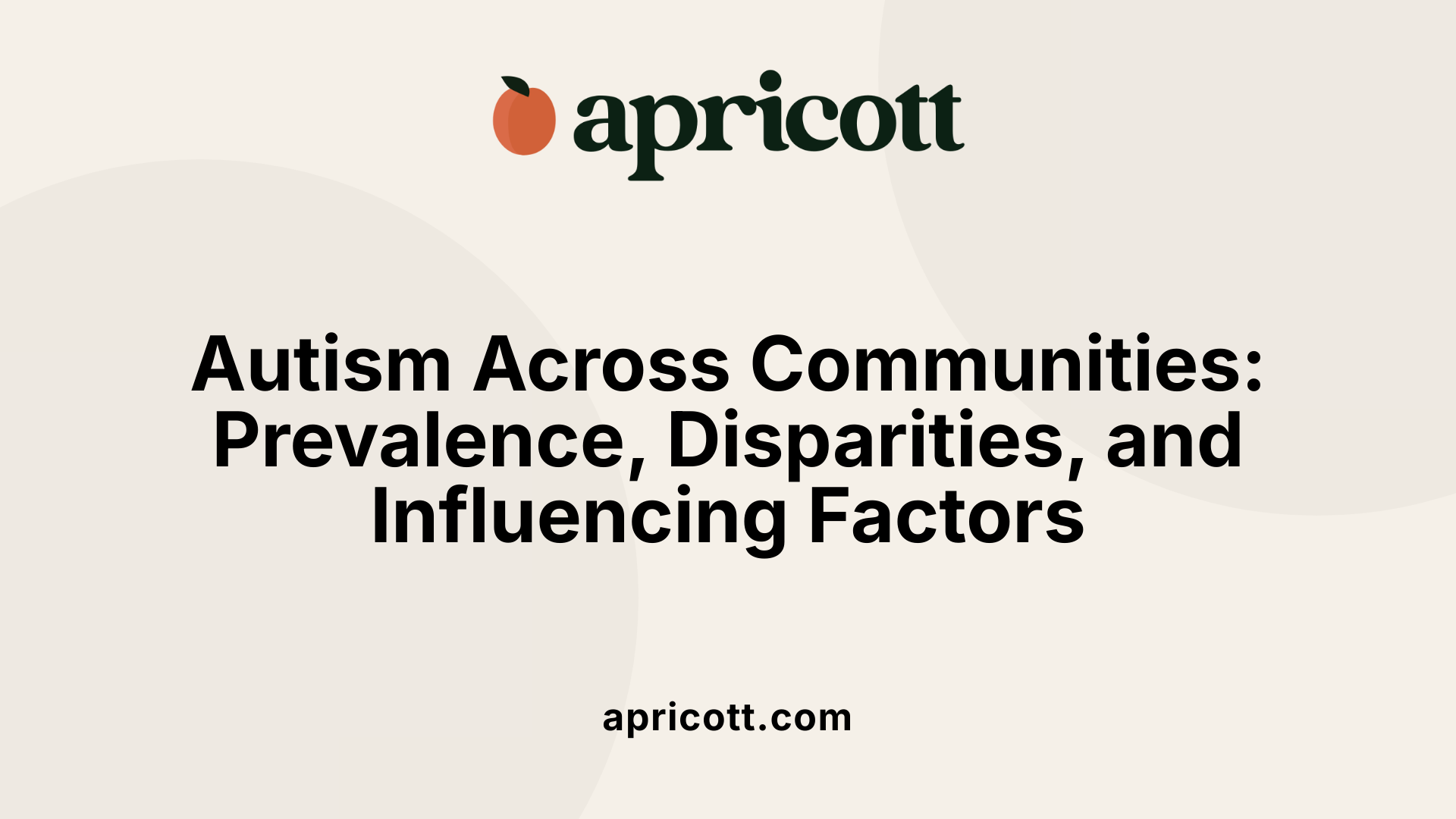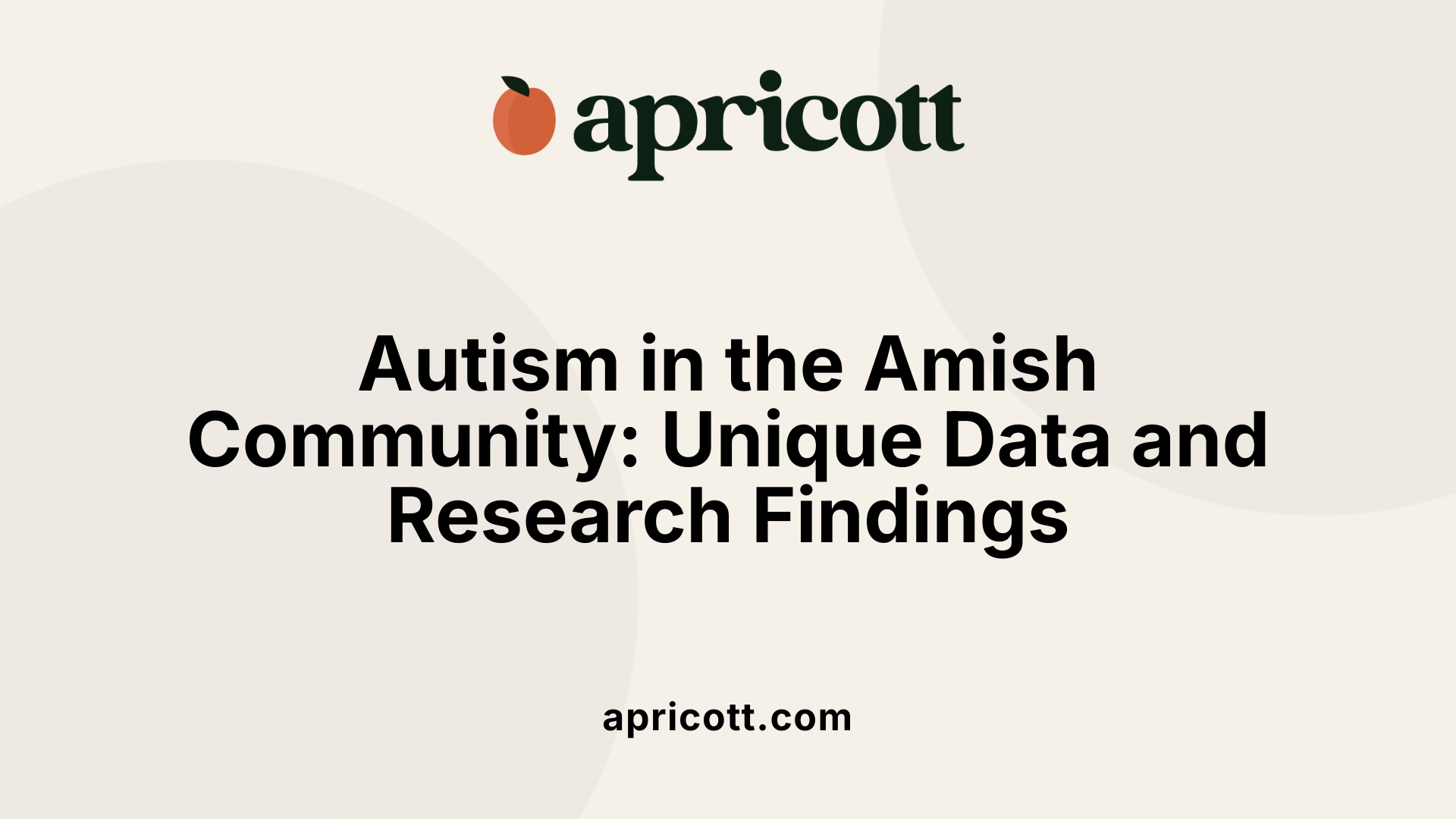August 4, 2025
Understanding Autism Prevalence in Unique Communities
Autism spectrum disorder (ASD) is a complex neurodevelopmental condition affecting individuals worldwide. While research has extensively documented its prevalence and causes across diverse populations, less is known about specific communities such as the Amish. This article delves into the prevalence of autism among Amish children, examines scientific findings related to its causes, dispels common misconceptions—particularly about vaccines—and explores genetic factors involved. By understanding these aspects, we aim to provide accurate, evidence-based insights into autism in unique populations and address prevailing myths.

Autism spectrum disorder (ASD) prevalence varies across different populations and over time. In the United States, recent data show that about 1 in 31 children, approximately 3.2%, aged 8 years have been diagnosed with ASD. Higher rates are reported in North America compared to Europe and Asia, which can be attributed to differences in diagnostic practices and awareness.
Globally, the World Health Organization estimates that roughly 1 in 100 children have autism, but actual rates tend to be higher in high-income countries due to better diagnostic systems. From 2000 to now, autism diagnoses have increased considerably. In 2000, the prevalence was about 1 in 150 children, but recent figures show it has risen to about 1 in 54 in the U.S., reaching approximately 0.72% overall.
Autism affects all racial, ethnic, and socioeconomic groups; however, disparities exist. Boys are diagnosed much more frequently than girls, with ratios reaching as high as 4:1. The methods used for diagnosis and the criteria applied significantly influence prevalence rates.
Current research indicates that autism is caused by a mix of genetic and environmental factors. Over 100 genes have been linked to increased autism risk, including rare mutations and common gene variants. Family studies suggest a strong hereditary component—family members of children with autism are at a higher risk.
Environmental influences also play a role. Factors such as maternal infections during pregnancy (like rubella), prenatal medication exposure (like valproic acid or SSRIs), exposure to environmental toxins such as pesticides or air pollution, and increased parental age are associated with greater risk. These factors are believed to interact with genetic vulnerabilities to influence early brain development.
Most comprehensive studies have established that vaccines do not cause autism. Extensive epidemiological research shows no association between vaccinations—including MMR or thimerosal-containing vaccines—and autism diagnosis. The increase in autism rates over time is attributed mainly to improved awareness, broader diagnostic criteria, and earlier screening.
A significant misconception persists that vaccines cause autism. This myth originated from a now-discredited study published in 1998 by Andrew Wakefield, which was retracted due to ethical violations and falsified data. Large-scale studies involving millions of children worldwide have shown no link between vaccines and ASD.
Research articles, reviews, and meta-analyses consistently reaffirm vaccine safety and dispel myths linking vaccines to autism. For example, a 2019 study confirmed that vaccinated and unvaccinated children have similar rates of autism diagnosis. Additionally, authoritative bodies like the CDC, WHO, and the National Academy of Sciences have publicly stated that there is no causal connection.
Genetics play a major role in autism, with heritability estimates ranging from 64% to 93%. Over 200 genes have been associated with increased risk, highlighting the genetic heterogeneity of ASD. Rare mutations, such as copy number variations and de novo mutations, are often involved, affecting neuronal development, synaptic functioning, and gene regulation.
Some genetic conditions, like mutations in the CNTNAP2 gene, have been linked to autism, especially in cases with additional neurological features like focal seizures and regression. These genetic factors help explain some of the diverse behavioral and developmental profiles seen in ASD.
Combating misinformation requires sharing accurate, scientifically validated information through reputable channels like healthcare professionals, government agencies, and autism advocacy groups. Promoting understanding of autism as a neurodiversity rather than a disease helps reduce stigma and encourages acceptance.
Effective strategies include targeted education campaigns, transparent communication, and debunking myths with clear evidence. Engaging autistic individuals, their families, and community leaders fosters trust and improves outreach efforts.
By emphasizing the importance of early diagnosis, access to support and services, and respecting individual differences, society can better address misconceptions and support autistic individuals.
| Population Group | Estimated Prevalence | Notes |
|---|---|---|
| United States (general) | 1 in 54 (~1.85%) | Data from CDC reflects recent diagnoses |
| World-wide | 1 in 100 | WHO estimate, varies by country |
| Non-Hispanic White Children | 1 in 44 (~2.27%) | Higher prevalence compared to other ethnic groups |
| Hispanic Children | 1 in 102 (~0.98%) | Lower reported prevalence, possibly due to underdiagnosis |
| Amish Children | ~1 in 271 (~0.37%) | Lower rate possibly due to reporting differences and genetics |
This table summarizes autism prevalence across different populations, highlighting variations and contributing factors.

Autism spectrum disorder (ASD) affects populations worldwide, but its prevalence varies among different groups. Recent data from the United States indicate that approximately 1 in 31 children—around 3.2% of 8-year-olds—have been diagnosed with ASD. Higher rates are often observed in North America compared to Europe and Asia, likely due to differences in diagnostic practices and awareness.
Globally, the World Health Organization estimates that about 1 in 100 children have autism. However, these rates tend to be higher in high-income countries, where advanced health systems allow for more comprehensive diagnosis. Since the early 2000s, autism diagnoses have seen a substantial increase, rising from about 1 in 150 children to about 1 in 54 in the U.S. today.
Autism affects all racial and socioeconomic groups, although prevalence is generally higher among boys than girls. Variations in diagnostic criteria and detection methods also influence reported rates. Nonetheless, autism remains a widespread neurodevelopmental condition across diverse communities.
Research points to a multi-factorial origin of autism, involving genetic, neurological, and environmental influences. Over 100 genes, including both rare mutations and common variants, have been associated with increased autism risk. Family studies suggest a strong genetic component, with up to 80% heritability.
Environmental factors also contribute, often interacting with genetic predispositions. These include maternal infections during pregnancy, prenatal medication exposure—such as to valproic acid or SSRIs—and advanced parental age. Exposure to environmental toxins like pesticides and air pollution during pregnancy is also considered influential.
Crucially, extensive studies have found no credible evidence linking vaccines to autism. The supposed connection, first proposed by a retracted and discredited study, has been thoroughly debunked through large-scale epidemiological research. Overall, autism results from complex interactions affecting early brain development, not from any single cause.
Popular myths wrongly claim that vaccines cause autism, but scientific evidence firmly refutes these claims. The original hypothesis stemmed from a flawed study by Andrew Wakefield, which was later retracted and discredited due to unethical conduct and fabricated data.
Multiple large studies and reviews have consistently shown no association between vaccines—such as the MMR vaccine—and autism. For instance, a 2019 study confirmed that children vaccinated with MMR have the same autism diagnosis rates as their unvaccinated peers. Moreover, agencies like the Centers for Disease Control and the National Academy of Sciences have concluded that vaccines are safe and not linked to autism.
In fact, the rising rates of autism are now attributed more to improved awareness, broader diagnostic criteria, and better screening, rather than vaccination efforts.
Genetics play a significant role in autism. Heritability estimates fall between 64% and 93%, underscoring the importance of genetic factors.
Scientists have identified over 200 autism-associated genes. These include rare mutations—like de novo mutations—and inherited variations that influence neuronal development and brain connectivity. Genes such as PLEKHA8 and SNCAIP are examples involved in increases in autism susceptibility.
Research also reveals that specific genetic subtypes correlate with distinct behavioral patterns, reinforcing the idea of autism as a genetically diverse spectrum. The interplay of numerous genetic factors shapes early neural development and influences autism's manifestation.
Combating misinformation requires delivering accurate, evidence-based information through trusted sources like health authorities and autistic-led organizations. Emphasizing autism as a neurodiverse condition rather than a disorder can help reduce stigma.
Effective strategies include targeted debunking—using clear, factual explanations—and engaging community leaders and educators to spread correct information. Supporting autistic individuals’ rights to privacy and autonomy, along with trauma-informed care principles, can also help address concerns and misconceptions.
Ongoing education, advocacy, and respectful dialogue are essential to fostering public understanding. These efforts help prevent delays in diagnosis and ensure access to appropriate support and services for autistic individuals.
| Population Group | Estimated Autism Rate | Notable Factors | Source/Notes |
|---|---|---|---|
| General US children (2023) | ~1 in 31 (3.2%) | Diagnostic improvements, awareness | CDC data |
| Amish children (Ohio & Indiana) | ~1 in 271 (~0.37%) | Lower reporting, different social dynamics | Recent Amish community study |
| Hispanic children | 2-3 times lower than non-Hispanic Whites | Possible underdiagnosis, reporting differences | Recent regional studies |
| Non-Hispanic Whites | Higher than Hispanics | Genetic, socioeconomic factors | Multiple epidemiological studies |
| Vaccinated children | Same prevalence as unvaccinated | No causal link evidence | 2019 large-scale study |
| Unvaccinated children | Same as vaccinated | No observed increase in autism rates | Multiple reviews |
| Amish genetic findings | Specific gene mutations | CNTNAP2 gene involvement reducing seizure/ regression | Case study with cortical dysplasia |
This overview highlights the variations in autism prevalence among populations and underscores the necessity of robust research and accurate reporting to inform public understanding.
While autism diagnosis rates are increasing worldwide, the prevalence among Amish children appears to be significantly lower than the general population, at roughly a third of the national rate. This lower observed rate may be influenced by differences in reporting behaviors, cultural factors, and genetics. Importantly, scientific research confirms that autism exists within the Amish community and that its causes are complex, involving genetic and environmental factors rather than vaccination status. There is no evidence supporting claims that vaccines cause autism or that autism prevalence in the Amish population differs significantly due to vaccination practices. Continued research and culturally sensitive outreach are essential to better understand autism across all populations, support affected individuals and families, and dispel myths rooted in misinformation.